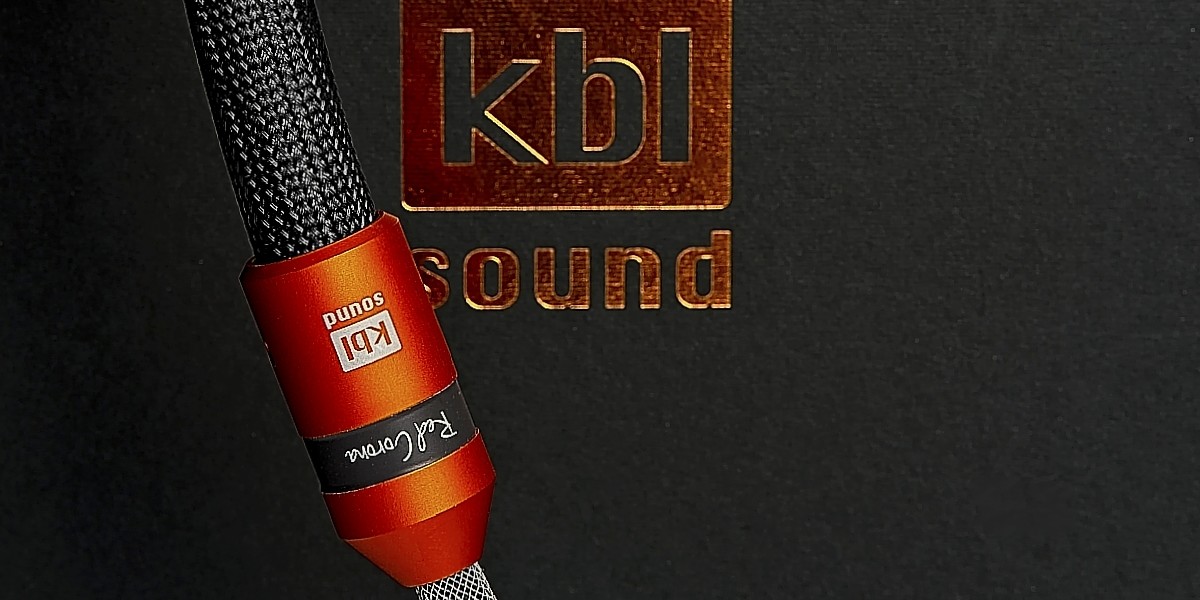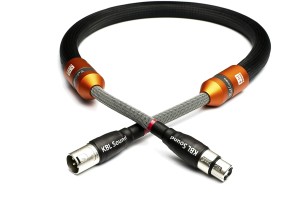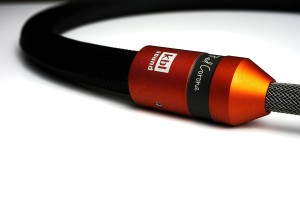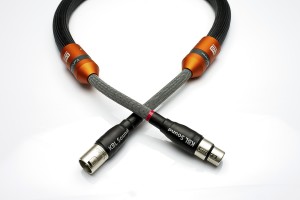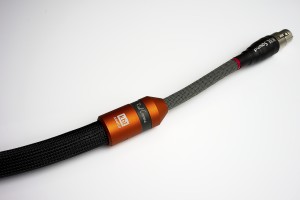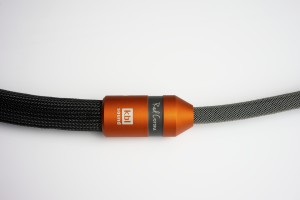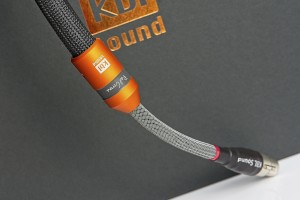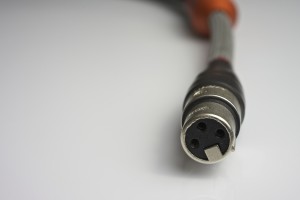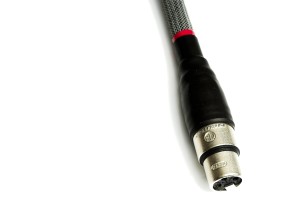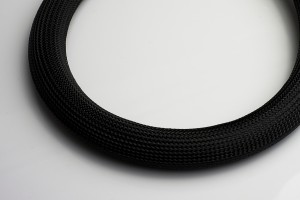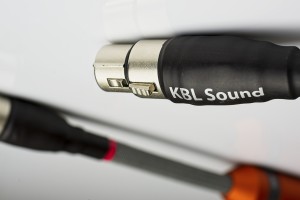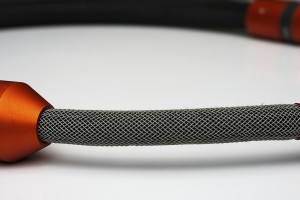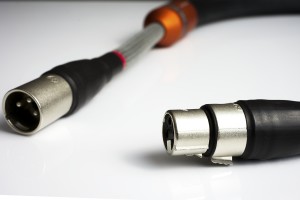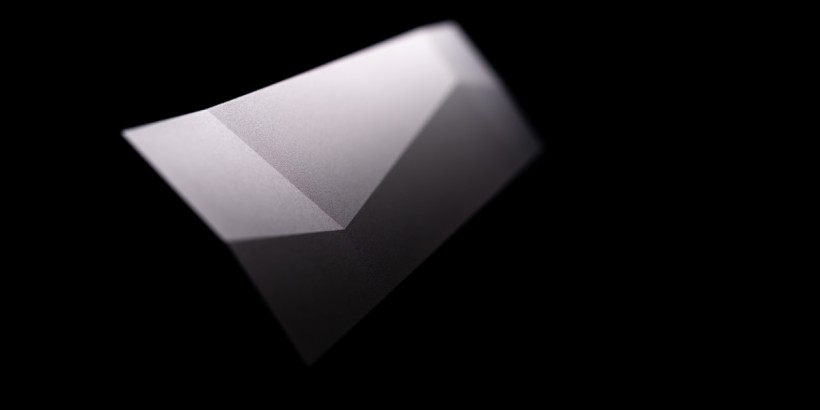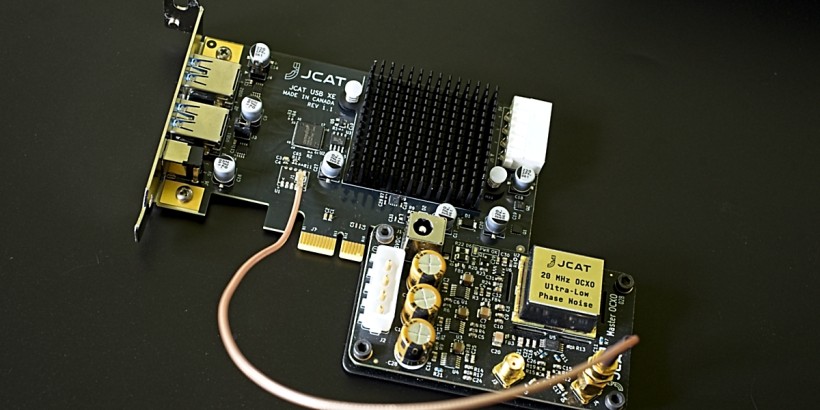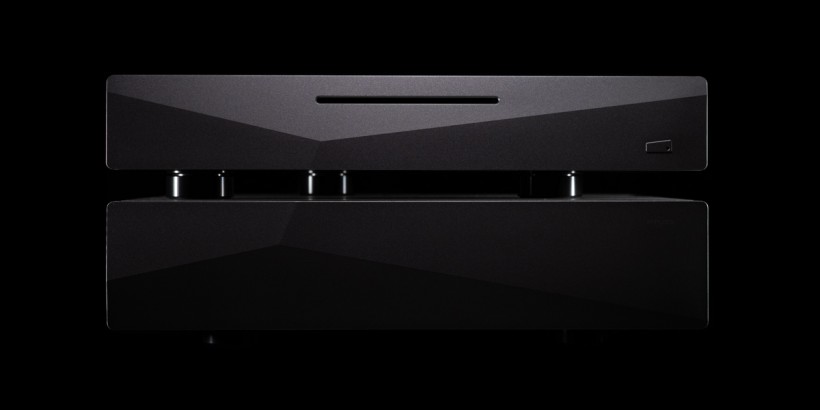During the last Audio Video Show in Warsaw, one of the leading Polish audio cables manufacturers, the KBL Sound, presented a completely new line of products called Red Corona. To get a taste of this interesting novelty I received a balanced analog interconnect for a review. So here we go – let me present to you the KBL Sound Red Corona XLR.
Introduction
The Red Eye series, later replaced by the Red Eye Ultimate, was in my opinion sort of a sweet spot in the KBL Sound’s lineup. Why? It did not quite equal the class of the flagship signal cables line, Himalaya, but for half the price of the latter, it offered much, much more than 50% of the performance. I don’t want to quantify this difference precisely, as it is rather subjective, but the fact remains that those who, like me, were delighted with the Himalaya cables (see HERE), but were not able to afford them, had an easy solution – the Red Eye Ultimate (see HERE and HERE). I also believe that those who made such a choice quickly forgot about few downsides and just enjoyed the impressive performance of cables Made in Poland knowing that they had bought something that could boldly compete with many much more expensive products of well-known brands. In one of my reviews I even indicated that one day I would probably purchase the Red Eye Ultimate cable set myself to pursue my dream of a fully Polish, high-end audio system (well, as fully Polish as possible, since most likely there won’t be any Polish high-end cartridge for my J.Sikora turntable). So I wrote down the Red Eye Ultimate for my dreamed system (obviously if money was no issue Himalaya would take its place), assuming that sooner or later I would realize this dream. 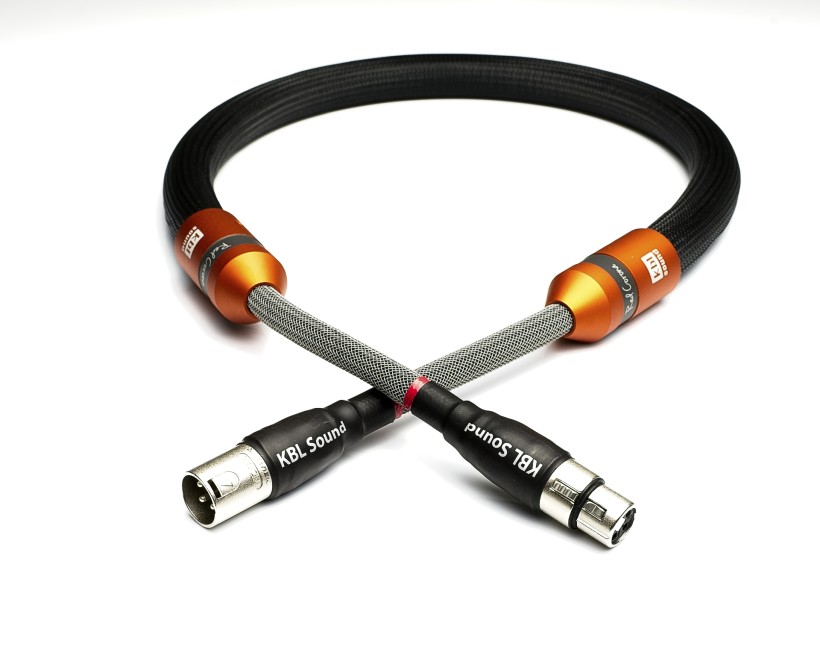 As it turns out, however, that won’t be possible because KBL Sound replaced the Red Eye Ultimate with a new series called Red Corona several months ago. The name still includes “Red” with suggests some affinity to the older series, but instead of “Eye” there is a “crown” (Corona) now, which suggests it is more then just an slight modification. At first, when I heard about this change in the brand’s lineup, I was a bit worried – after all, the Red Eye Ultimate’s performance really suited me plus I had to assume that the new series would be probably more expensive. As it turns out, it is a bit more expensive (about 10%), but there is a bonus – a balanced interconnect, that was lacking in the Red Eye Ultimate series. And it so happened, that the manufacturer decided that he would deliver this particular model to me first for a review. There are two more noteworthy differences compared to the previous line. One can be seen with an naked eye, namely the Red Corona does not feature a red sleeve. Instead… let me get back to that in a moment. Another difference in relation to the predecessors is the material of the conductors the new cables were made of. The Red Eye Ultimate interconnect (unbalanced one) was made of mono crystal silver, while for the Red Corona manufacturer decided to use mono crystal copper instead.
As it turns out, however, that won’t be possible because KBL Sound replaced the Red Eye Ultimate with a new series called Red Corona several months ago. The name still includes “Red” with suggests some affinity to the older series, but instead of “Eye” there is a “crown” (Corona) now, which suggests it is more then just an slight modification. At first, when I heard about this change in the brand’s lineup, I was a bit worried – after all, the Red Eye Ultimate’s performance really suited me plus I had to assume that the new series would be probably more expensive. As it turns out, it is a bit more expensive (about 10%), but there is a bonus – a balanced interconnect, that was lacking in the Red Eye Ultimate series. And it so happened, that the manufacturer decided that he would deliver this particular model to me first for a review. There are two more noteworthy differences compared to the previous line. One can be seen with an naked eye, namely the Red Corona does not feature a red sleeve. Instead… let me get back to that in a moment. Another difference in relation to the predecessors is the material of the conductors the new cables were made of. The Red Eye Ultimate interconnect (unbalanced one) was made of mono crystal silver, while for the Red Corona manufacturer decided to use mono crystal copper instead.
For the two top lines (Red Eye and Himalaya) the KBL Sound designers have long experimented with these two materials, often building prototypes made of both materials, comparing them, as well as collecting opinions of their trusted clients and audiophile friends. After all, it is the listening experience and customers’ satisfaction that should be quite important for every manufacturer. When I spoke to him, Mr Robert emphasized that they were able to achieve similar results in terms of performance level, although slightly different in sonic character. So the conductor was more a choice of a taste then actual performance level of the product it was made of. This time they decided for copper and I am sure that the choice was based on a in-depth analysis and countless auditions.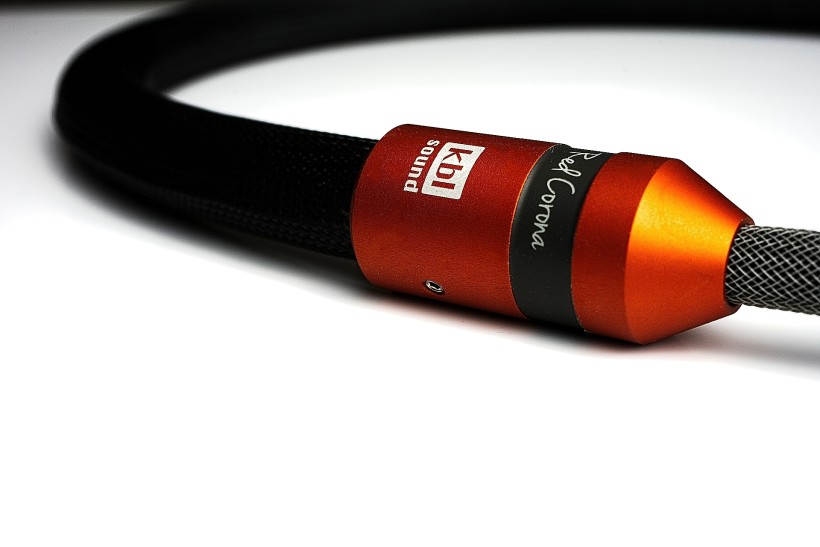 The conductors, separately for positive and negative runs, are placed in Teflon tubes and the air acts as a dielectric. The cable is quite thick, because the manufacturer pays a lot of attention to vibrations damping. The cable throughout most of its length is therefore relatively thick, and this part features a black sleeving. Only the short end runs of the cable on both ends are slightly thinner (and gray, not black) and they are terminated with Neutrik NC3MX / FX plugs (the RCA version sports WBT 0152 Cu nextgen connectors). On both ends, where the thicker part of the cable transforms into the thinner one, manufacturer used perfectly made and finished aluminum parts. The visual effect is one thing – these orange muffs with white inscriptions and a dark gray band distinguish the Red Corona among other cables creating an astonishing look. Their main role though is actually vibration damping. Which does not change the fact that for me these are probably the most beautiful audio cables I have ever dealt with.
The conductors, separately for positive and negative runs, are placed in Teflon tubes and the air acts as a dielectric. The cable is quite thick, because the manufacturer pays a lot of attention to vibrations damping. The cable throughout most of its length is therefore relatively thick, and this part features a black sleeving. Only the short end runs of the cable on both ends are slightly thinner (and gray, not black) and they are terminated with Neutrik NC3MX / FX plugs (the RCA version sports WBT 0152 Cu nextgen connectors). On both ends, where the thicker part of the cable transforms into the thinner one, manufacturer used perfectly made and finished aluminum parts. The visual effect is one thing – these orange muffs with white inscriptions and a dark gray band distinguish the Red Corona among other cables creating an astonishing look. Their main role though is actually vibration damping. Which does not change the fact that for me these are probably the most beautiful audio cables I have ever dealt with. 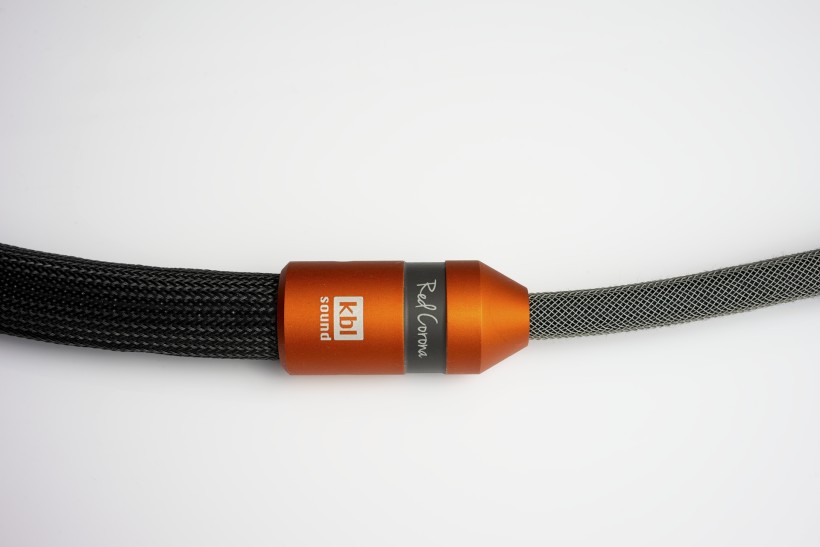 The new series includes analogue interconnects (RCA, XLR and phono), digital ones (RCA and XLR), speaker and power cables, as well as jumpers. I received the cable for a review in a neat, visually quite attractive box, despite the fact that it was a simple cardboard one. Now it is mostly gray with some orange elements (previously it was orange). I admit that somehow during the Audio Video Show in Warsaw I missed the premiere of these cables, so I had no opportunity to see them before. I realize how it sounds and what you may think of me but… as soon as I opened the box I fell in love with the Red Corona. The orange color has always belonged to my favorites. Its combination with black and gray has always particularly appealed to me as well. And there you go, the KBL Sound decided to make cables using exactly this color combination just to wow me (kidding, of course). As always with this brand, the quality of make and finish is superb, so instead of, as I do in most cases when testing some cables, simply plugging the Red Corona to the system, I just kept it in my hands for a long time admiring its appeal, my preciousssss… If it were not for my innate laziness, I would have probably turned the CD player and amplifier around so that I could just keep looking at the IC while listening to the music. Both, the player (Ayon CD 35 HF) and the amplifier (GrandiNote Shinai interchangeably with Ayon Crossfire III) fortunately weigh a lot, so ultimately I gave up on this silly idea. I plugged the tested interconnect into CD35 HF on one end and Shinai on the other, stating that, despite the large diameter, the Red Corona is quite flexible, which facilitates installation. Now I could finally focus on the primary function of any audio cable – its performance, instead of its (quite distracting in this case) look.
The new series includes analogue interconnects (RCA, XLR and phono), digital ones (RCA and XLR), speaker and power cables, as well as jumpers. I received the cable for a review in a neat, visually quite attractive box, despite the fact that it was a simple cardboard one. Now it is mostly gray with some orange elements (previously it was orange). I admit that somehow during the Audio Video Show in Warsaw I missed the premiere of these cables, so I had no opportunity to see them before. I realize how it sounds and what you may think of me but… as soon as I opened the box I fell in love with the Red Corona. The orange color has always belonged to my favorites. Its combination with black and gray has always particularly appealed to me as well. And there you go, the KBL Sound decided to make cables using exactly this color combination just to wow me (kidding, of course). As always with this brand, the quality of make and finish is superb, so instead of, as I do in most cases when testing some cables, simply plugging the Red Corona to the system, I just kept it in my hands for a long time admiring its appeal, my preciousssss… If it were not for my innate laziness, I would have probably turned the CD player and amplifier around so that I could just keep looking at the IC while listening to the music. Both, the player (Ayon CD 35 HF) and the amplifier (GrandiNote Shinai interchangeably with Ayon Crossfire III) fortunately weigh a lot, so ultimately I gave up on this silly idea. I plugged the tested interconnect into CD35 HF on one end and Shinai on the other, stating that, despite the large diameter, the Red Corona is quite flexible, which facilitates installation. Now I could finally focus on the primary function of any audio cable – its performance, instead of its (quite distracting in this case) look.
Sound
As I’ve already mentioned, I had an opportunity to get acquainted with the whole Red Eye Ultimate series, currently replaced by the Red Corona. Firstly, I tested a set including an analogue interconnect, speaker cables and a power cord, and then separately a phono cable. Long story short – these may not be the best cables in the world (even the KBL Sound’s lineup includes a more expensive series, the Himalaya), but there was nothing in their performance I complained about. In my opinion they had no obvious flaws, but quite a long list of advantages. They were excellent in many respects and for many music fans could easily be a choice for life, so to speak. At least for those who, like me, value refined, very natural, smooth, musical, well-balanced sound. So the question can be asked whether such a successful product line really required any further refinement. On the other hand though, one has to realize that the Ultimate series was … an improved version of the already impressive Red Eye line and it did offer a significant performance improvement. Plus there is this old, universal truth – the whole audio industry and our hobby are about a constant pursuit of perfection (one that can’t really be achieved), so one can always assume that no matter how good an audio product or system is it can always be further improved. 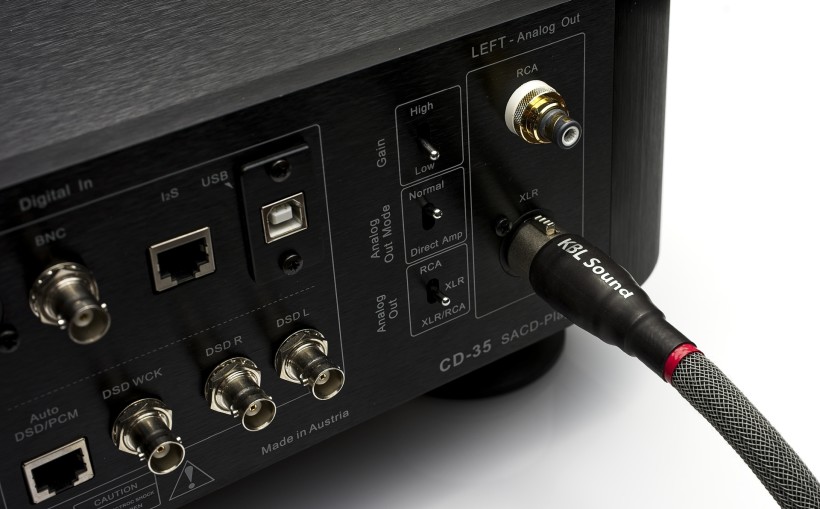 I assume therefore, that the KBL Sound designers were guided by this constant pursuit of perfection. One of them told me during our meeting, or actually confirmed what I heard from many designers, that work they do on each subsequent design is a new experience, a process of learning / discovering new things, new solutions that allows them to achieve even better sonic results with their new products. Sometimes, solutions developed for the needs of top models can be at least partially used for cheaper ones, which allows the latter to achieve a new, higher level of performance. Was this the case with the Red Corona? I do not know for sure, but having experience with many previous models of this Polish brand I was pretty sure that the Red Corona replaced the Red Eye Ultimate because it offered a significant progress in terms of performance.
I assume therefore, that the KBL Sound designers were guided by this constant pursuit of perfection. One of them told me during our meeting, or actually confirmed what I heard from many designers, that work they do on each subsequent design is a new experience, a process of learning / discovering new things, new solutions that allows them to achieve even better sonic results with their new products. Sometimes, solutions developed for the needs of top models can be at least partially used for cheaper ones, which allows the latter to achieve a new, higher level of performance. Was this the case with the Red Corona? I do not know for sure, but having experience with many previous models of this Polish brand I was pretty sure that the Red Corona replaced the Red Eye Ultimate because it offered a significant progress in terms of performance.
For now, to look for confirmation of this (strong) theory, I received the balanced analogue interconnect. During the test for most of the time, it connected the fantastic Ayon Audio CD35 HF CD/SACD player with the tube integrated amplifier Crossfire III, and then with my Class A solid-state integrated, GrandiNote Shinai. From the very beginning of the listening session I felt that it was an extremely enjoyable, listener-friendly cable. This is not achieved using some shortcuts – the sound is not overly warm and mellow, or artificially smoothed out – not at all! Although some cheap cables I know create a similar first impression. The point is that the latter are not as resolving, do not deliver such a huge wealth of information, are not so open and spacious sounding as the Red Corona. 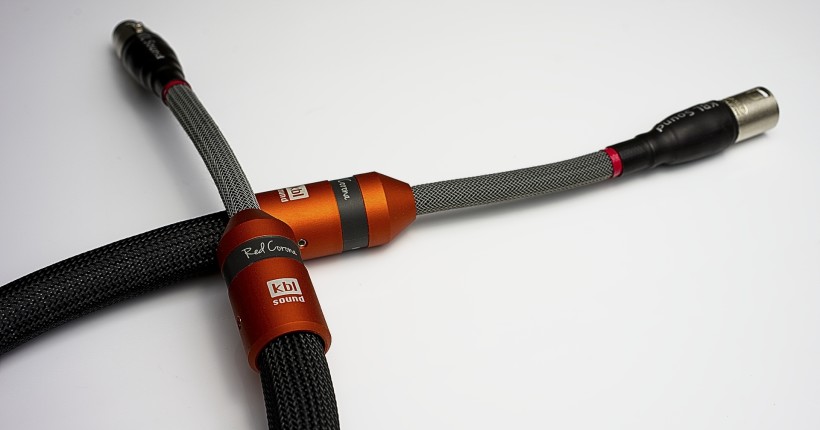 As it turned out, with this interconnect, any well-recorded acoustic music sounds simply remarkable. It is a result of a combination of several qualities. As it reads on the manufacturer’s website, the new series “sounds even more spatially” and it is not just a sales pitch – it actually does. However it, by no means, artificially „blows up” the space where instruments play in. The impression is rather created by the air tightly filling a realistic volume of the soundstage. So the instruments have a way to truly breathe, and the sounds (waves) have means (which is also the air) to spread around and they can do it freely, whether moving directly towards the listener or surrounding surfaces, from which they reflect, creating a beautiful, natural ambiance. It is also a matter of long, full reverb, and this is a feature that many, even otherwise outstanding cables, lack. There are only but few elements that irritate me as much as the shortened reverbs – without this element, most acoustic instruments simply don’t sound natural.
As it turned out, with this interconnect, any well-recorded acoustic music sounds simply remarkable. It is a result of a combination of several qualities. As it reads on the manufacturer’s website, the new series “sounds even more spatially” and it is not just a sales pitch – it actually does. However it, by no means, artificially „blows up” the space where instruments play in. The impression is rather created by the air tightly filling a realistic volume of the soundstage. So the instruments have a way to truly breathe, and the sounds (waves) have means (which is also the air) to spread around and they can do it freely, whether moving directly towards the listener or surrounding surfaces, from which they reflect, creating a beautiful, natural ambiance. It is also a matter of long, full reverb, and this is a feature that many, even otherwise outstanding cables, lack. There are only but few elements that irritate me as much as the shortened reverbs – without this element, most acoustic instruments simply don’t sound natural.
As I mentioned earlier, the Red Corona is capable of delivering an abundance of information, details and subtleties, and in addition, it does it in a very clear, but non-aggressive way, without attracting listener’s attention to themselves, which would distract them from listening to the music as a whole. Again, it plays a huge role with acoustic instruments, because one can hear not only the sounds played by the instruments, but also (if they were captured in the recording) all the others non-musical ones. It is about elements such as the sounds of fingers sliding on the strings, small, not necessarily intended taps on the instrument, working the valves in sax or trumpet, creaking piano pedals, breathing, etc. All this combined with another advantage, the ability to create an impression of instrument’s/performers’ presence in the room, builds exceptional realism of the presentation. When listening to recorded music, it is impossible to completely reconstruct all the impressions, feelings we experience during a live event. The Red Corona, however, gets listeners closer to such an unattainable ideal then most competitors I know. 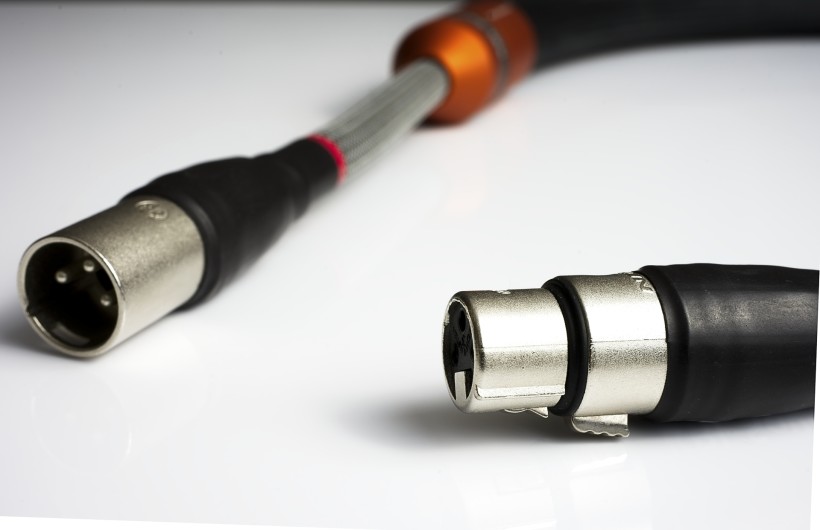 One of the evenings spent with the Red Corona I devoted entirely to various trumpet recordings (I mean with trumpet as leading instrument). Each time this instrument sounded extremely natural and convincing. There was this beautiful, natural dullness but combined with equally natural sparks piercing my ears from time to time (when needed). I could clearly hear Stańko, or Hugh Masakela blowing air into a mouthpiece and working the valves. The sound was tangible, close, present, full of air and natural energy of this instrument. It attracted attention, drew me in, invited me to immerse myself in an exciting musical event. The saxophone or trombone sounded equally well, but this day it was the trumpet that played „the first fiddle” so to speak. Even though the sound of a trumpet was so immersive, it was impossible not to pay attention to the accompanying percussion cymbals in many recordings. These were particularly well differentiated, sounded energetically, had proper weight, and the decay, when needed, was equally impressive. The Red Corona was able to show the immediate impulse of a stick hitting a cymbal and the energetic response of a vibrant metal. When necessary it was able to extinguish the impulse in equally immediate fashion.
One of the evenings spent with the Red Corona I devoted entirely to various trumpet recordings (I mean with trumpet as leading instrument). Each time this instrument sounded extremely natural and convincing. There was this beautiful, natural dullness but combined with equally natural sparks piercing my ears from time to time (when needed). I could clearly hear Stańko, or Hugh Masakela blowing air into a mouthpiece and working the valves. The sound was tangible, close, present, full of air and natural energy of this instrument. It attracted attention, drew me in, invited me to immerse myself in an exciting musical event. The saxophone or trombone sounded equally well, but this day it was the trumpet that played „the first fiddle” so to speak. Even though the sound of a trumpet was so immersive, it was impossible not to pay attention to the accompanying percussion cymbals in many recordings. These were particularly well differentiated, sounded energetically, had proper weight, and the decay, when needed, was equally impressive. The Red Corona was able to show the immediate impulse of a stick hitting a cymbal and the energetic response of a vibrant metal. When necessary it was able to extinguish the impulse in equally immediate fashion.
So far I’ve described only how particularly delighted I was with the presentation of acoustic music without even once mentioning any electric one. Why? Well, because the Red Corona’s presentation of the former positions, in my opinion, this interconnect in a higher league than its price indicates. Let’s skip the discussion about prices of not only cables, but also all audio components. My opinion on this subject hasn’t changed – the market went nuts, but this is the reality today whether we like it or not. So considering the reality of the audio market today, I dare to claim that when it comes to acoustic music the new KBL Sound model simply outperforms many, even more expensive competitors. Hence my delight. When it comes to electric/electronic music it is still very good, competitive model, although not necessarily so remarkable, so much better then other cables from similar price range. There is actually one reason for that. One has to take into account that a large portion of recordings of the electric music (in other words, rock, blues and some others) does not necessarily offer audiophile quality. To make them sound really good it is not enough to offer a good PRAT, or high energy and dynamics (the Red Corona does not lack in these areas). What you need is an ultimate control and definition of low frequencies combined with richness, energy and power of this range. 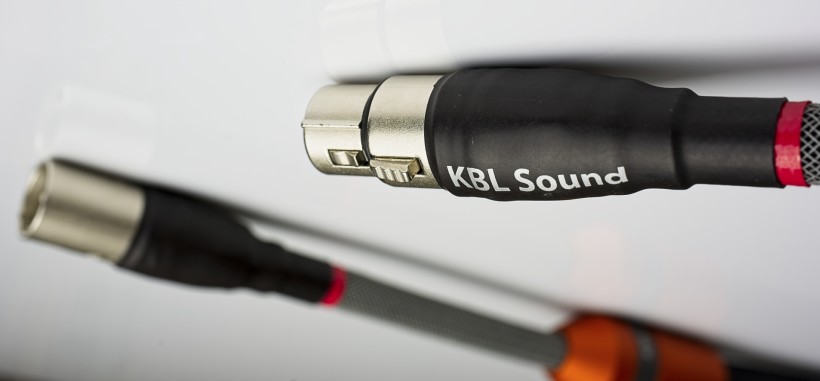 Don’t get me wrong – the Red Corona will stand its ground in these areas too, but what I mean is that it won’t as easily outperform competitors as it does when it comes to acoustic music. It’s just that… allow me to speculate a bit here based on my experience with both, the Red Eye Ultimate and the Himalaya, series. In both cases it were the power cables that were largely responsible for the outstanding presentation of the bass in every respect. In both cases I had full sets at my disposal, meaning interconnects, speaker and power cables. When combined, the synergy effect appeared, and the features of individual cables complemented each other perfectly. So, now comes the speculation. I guess that if I had a full set of the Red Corona at my disposal also this time, I would complement the electric music as much as the acoustic one.
Don’t get me wrong – the Red Corona will stand its ground in these areas too, but what I mean is that it won’t as easily outperform competitors as it does when it comes to acoustic music. It’s just that… allow me to speculate a bit here based on my experience with both, the Red Eye Ultimate and the Himalaya, series. In both cases it were the power cables that were largely responsible for the outstanding presentation of the bass in every respect. In both cases I had full sets at my disposal, meaning interconnects, speaker and power cables. When combined, the synergy effect appeared, and the features of individual cables complemented each other perfectly. So, now comes the speculation. I guess that if I had a full set of the Red Corona at my disposal also this time, I would complement the electric music as much as the acoustic one.
Let me back up my opinion with a few recordings I listened to with the Red Corona. For example, in the case of the Pink Floyd’s quite well-recorded “The Wall” album, I did not have any objections. Obviously the bass is not the key/leading element of this music, but Waters’ bass guitar, or Wright’s keyboard’s lower octaves, sometimes do go really deep down, and the Red Corona did not have any problems with presenting even the lowest frequencies properly, with authority and control. The special effects such as helicopter or explosion, sounded impressive, and the drums were fast and taut. The same was true for the next classic album, the Dire Straits “Brothers in Arms” (45 r.p.m. released by Mobile Fidelity). The bass guitar determining the pulse of the recordings was well controlled and differentiated, it was able to deliver a proper kick or slam if you will, same as it did on Marcus Miller’s album. It was only when I reached for the albums of the bands that did not really pursue the highest quality of their recordings, say Rush or AC/DC, that there was not proper control of the lower part of the range. You could say that the KBL Sound IC simply presented the truth about these recordings – these were imperfect and so they had to presented in such a way. It’s just that some other cables, including the same brand’s ICs from other series when combined with power and speaker cables, were able to impose more order and focus upon the bass range, which resulted in a better performance. Would it also be so in the case if the Red Corona’s full set? I did not have a chance to check it out, but if I had to bet, I would say that it probably would work the same way as with the Red Eye Ultimate or Himalaya. 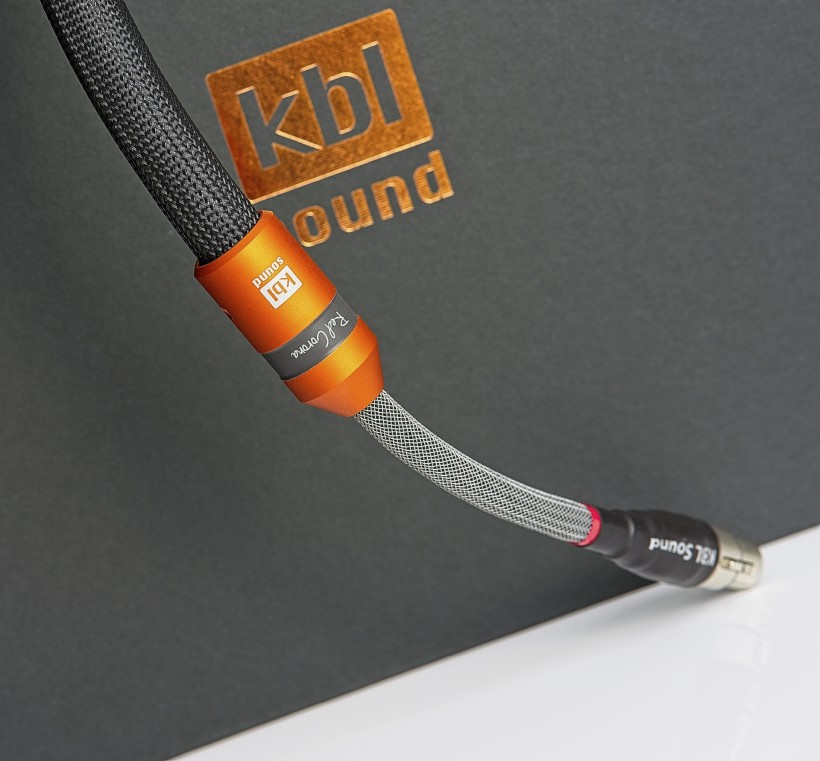
Summary
I am sure that you are aware of the fact that there are no perfect products in audio, i.e. those that do everything perfectly. The fact, that audio is an art of compromise is actually a quintessence of our hobby, but also of the whole industry. So, it will not be surprising when I say that the KBL Sound Red Corona balanced interconnect is not a perfect representative of its species. It is not perfectly neutral, perfectly faithful to recordings and does not provide the ultimate control of the bass range. What makes it a great products is the fact, that at the same time the list of its qualities is much, much longer. So despite some compromises designers had to make, the final result is definitely worth your attention. In acoustic music, especially great live recordings, the Red Corona is simply an outstanding performer – it delivers smooth, coherent, colorful (which does not mean that it is colored!), open, spatial, engaging and incredibly musical presentation.
Except for the top, so much more expensive, Siltech Triple Crown IC, I do not know any other interconnect (this also applies to Himalaya), that I would rather have for such recordings in my system instead of the Red Corona. And since I listen mostly to such acoustic (but not necessarily live) recordings, this Polish cable is simply my dream IC. It does something extraordinary with the sound of acoustic instruments. I may even say that it “improves” what was actually recorded, as it makes acoustic instruments sound more like what I know from live performances. I realize how it sounds, but I will stick to this opinion. This is a certain modification of the presentation obviously, so it does not stick strictly to the idea of high fidelity, but from mine, and all those rather seek a sound as close to live performance as possible rather then ultimately faithful to a recording, it is a huge advantage, an unique feature of the Red Corona. There are some other cables (let me once again point out the KBL Sound’s own Himalaya but also the Siltech Triple Crown), which provide better (electric) bass control, that I sometimes missed a bit with the Red Corona, but I suspect that this element could be largely improved if the IC is used in set with the KBL Sound’s own power (and speaker) cables. Long story short – my potential future reference Polish high-end cables, the Red Eye Ultimate, are gone, but I’ve stopped regretting it just minutes after I got to listen to the Red Corona. With this new IC I’ve found a new favorite that I could use in my (future) high-end audio system made in Poland. I strongly suggest that you check it out in your systems – it’s definitely worth it!
Technical specification (according to manufacturer):
- Conductors: highest purity mono crystal OCC copper
- Termination: WBT 0152 Cu nextgen plugs
- Balanced version available using Neutrik XLR NC3MX/FX plugs
- Also available as phono interconnects (the conductor is OCC silver), on one side terminated with RCA plugs, and on the side of the arm either 5 DIN or RCA
- Standard lengths available: 1 m, 1.5m, 2m
- Other lengths available upon request
Prices (when reviewed):
- KBL Sound Red Corona XLR: 2515 EUR /1m; 3057 EUR / 1,5m; 3596 EUR / 2m
Manufacturer: KBL Sound
Associated equipment:
- Analogue front end: J.Sikora Basic MAX turntable, Schroeder CB tonearm , AirTight PC-3 and Kondo IO-M catridges, phonostages: Grandinote Celio mk IV, ESE Lab Nibiru V 2.5
- Digital source: a passive, dedicated PC with WIN10, Roon, Fidelizer Pro 7.3, JCat USB Femto card with Bakoon battery power supply, Hdplex linear power supply for PC, JCAT USB Isolator
- D/A Converter: LampizatOr Golden Atlantic
- CD/SACD Player: Ayon Audio CD 35 HF
- Power amplifier: GrandiNote Shinai and Ayon Audio Crossfire III integrated
- Preamplifier: Audia Flight FLS1
- Loudspeakers: Ubiq Audio Model ONE Duelund Edition. GrandiNote MACH4
- Interconnects: Hijiri Million (RCA), Less Loss Anchorwave (RCA), KBL Sound Zodiac XLR, TelluriumQ Silver Diamond USB
- Speaker cables: LessLoss Anchorwave
- Power cables: LessLoss DFPC Signature, Gigawatt LC-3
- Power: Gigawatt PF-2 MK2 and ISOL-8 Substation Integra; a dedicated power line with Gigawatt LC-Y in-wall cable; Gigawatt G-044 Schuko and Furutech FT-SWS-D (R)
- Racks: Base VI, Rogoz Audio 3RP3/BBS
- Anti-vibration accessories: ROGOZ-AUDIO SMO40 and CPPB16 platforms and ROGOZ AUDIO BW40MKII feet, Franc Accessories Ceramic Disc Slim Feet and Wood Block Platform


